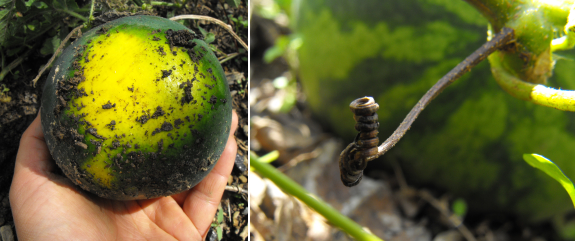
How to tell if a watermelon is ripe

There's nothing more
depressing than picking one of the two watermelons
in your garden, cutting it open, and discovering that it's not yet
ripe. That's what happened in our garden last year, so this year
we grew more watermelons and started learning the secrets to
ensure we only pick the watermelons when they are fully ripe.
Some folks say they can tell when their watermelons are ripe by
thumping the side and listening for a hollow sound. Good
luck. Others count the days since they planted their seeds and
look at the days to maturity on the seed packet --- this is a good
start, but doesn't factor in chilly weather droughts, and other
features that set your ripening back by a day, a week, or a month.
I've found two signs that seem to be much more fail-safe. A ripe
watermelon will turn yellow, tan, or white on the portion touching the
ground --- the Sugar Baby in the photo on the left is a great
example. This pale spot can be harder to see on lighter green
watermelons, like the Dixie Queen on the right. Here, I focus on
the tendrils directly opposite the stem running to the
watermelon. Once these tendrils start to dry up and turn brown,
your watermelon should be juicy and sweet.
As a final note, we grew four varieties of watermelons this year ---
Sugar Baby, Dixie Queen, Early Moonbeam, and Sweet Favorite
Hybrid. Sugar Baby won the prolific fruit prize and Dixie Queen
won the taste test (but had very few fruits.) Early Moonbeam was
more of a novelty melon, with its yellow flesh, while we never actually
got a fruit from the Sweet Favorite Hybrid. It's always worth
planting several varieties if you have a fruit or vegetable that
doesn't seem to be working for you --- chances are that one of the
varieties will become your garden's new star!
Want more in-depth information? Browse through our books.
Or explore more posts by date or by subject.
About us: Anna Hess and Mark Hamilton spent over a decade living self-sufficiently in the mountains of Virginia before moving north to start over from scratch in the foothills of Ohio. They've experimented with permaculture, no-till gardening, trailersteading, home-based microbusinesses and much more, writing about their adventures in both blogs and books.
Want to be notified when new comments are posted on this page? Click on the RSS button after you add a comment to subscribe to the comment feed, or simply check the box beside "email replies to me" while writing your comment.
